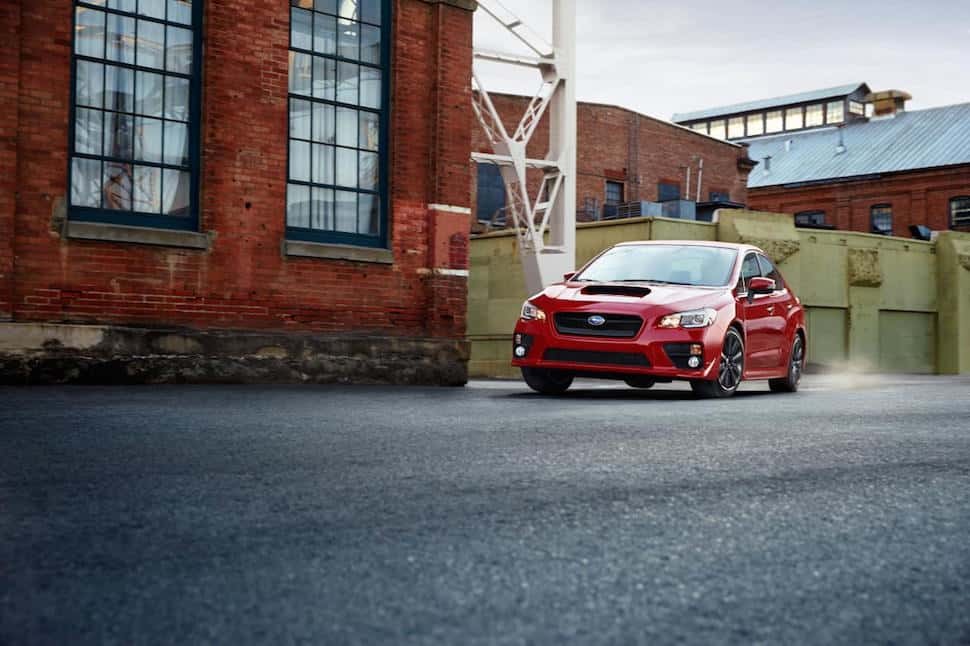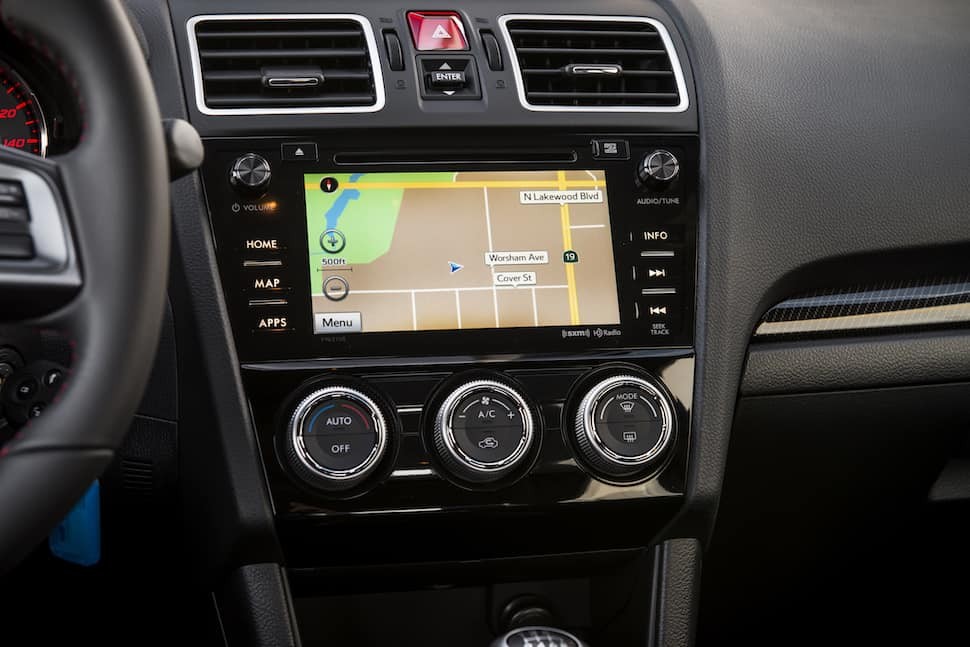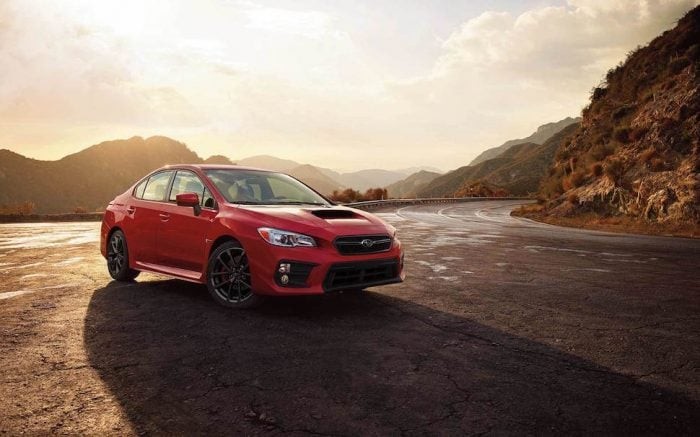The Subaru WRX holds a special place in the hearts of car enthusiasts. Born from the humble Impreza, it transformed into a performance icon, blending rally-inspired thrills with everyday usability. One of the key metrics that defines its sporty character is its 0-60 mph acceleration time. Let’s delve into what makes the WRX’s 0-60 performance so compelling.
The Heart of the Acceleration: WRX Engine and Powertrain
2017 WRX. Photo: Subaru- Engine: 2.0L turbocharged flat-4
- Power Output: 268 horsepower
- Torque: 258 lb-ft
- Transmission: 6-speed manual transmission or optional CVT
- Drive Configuration: Symmetrical All-Wheel Drive (AWD)
At the core of the WRX’s impressive 0-60 mph sprint is its potent 2.0L turbocharged flat-4 engine. This engine delivers a significant 268 horsepower and 258 lb-ft of torque, figures that firmly place the WRX in the sports sedan category. The turbocharger is instrumental in boosting the engine’s output, effectively doubling the power compared to its naturally aspirated Impreza sibling. This power surge is immediately apparent when you put your foot down, making it clear that the WRX is built for more than just mundane commutes. For those seeking even more zest, later models like the 2022 Subaru WRX push the boundaries further, boasting 271 horsepower while maintaining the same torque figure.
The driving experience of the WRX is characterized by a sensitive throttle and a clutch that demands a practiced foot for smooth launches. It’s a car that responds best to assertive inputs, rewarding drivers who aren’t afraid to push it. Achieving consistently smooth and quick launches for optimal 0-60 times requires familiarity and finesse, a testament to the WRX’s engaging driver-focused design.
 2017 subaru wrx review
2017 subaru wrx review
While the WRX excels in delivering rapid acceleration, some drivers may notice characteristics like turbo lag at lower RPMs and a slight flat spot in the power delivery around 4,000 RPM. These nuances are part of the turbocharged engine’s nature and contribute to the WRX’s raw, unfiltered performance feel. The engine note, while not traditionally melodic, is functional and provides feedback, though relying purely on auditory cues for gear changes can be challenging at higher revs.
The power delivery in the WRX is often described as immediate, almost like an on/off switch. This responsiveness contributes to its quickness, but it also means the WRX feels more like a very fast machine rather than a seamlessly refined sports car in terms of power delivery. In contrast, competitors like the Volkswagen Golf R, with its similar 2.0-liter turbo engine producing 292 hp and 280 lb-ft of torque, offer a more polished and linear power delivery.
WRX 0-60 and Handling Dynamics
2017 WRX. Photo: Subaru- Suspension: Independent front and rear suspension
- Brakes: Four-wheel disc brakes with ABS
- Wheels: 17-inch alloy wheels
- Tires: High-performance tires
- Acceleration: 0 to 60 mph in approximately 5.5 seconds (manual transmission)
- Top Speed: Electronically limited to around 155 mph (varies based on model and configuration)
The Subaru Wrx 0-60 mph time is officially quoted at approximately 5.5 seconds for models equipped with a manual transmission. This figure is a strong indicator of its performance capabilities, placing it firmly in contention with other sports sedans in its class. This rapid acceleration is not just about the engine; it’s a product of the WRX’s well-engineered handling and drivetrain.
The WRX chassis is designed for sharp handling, exhibiting tenacious grip in corners, even over uneven surfaces. The body motion, while noticeable, actually contributes to the car’s compliant ride quality, making it surprisingly comfortable for daily driving. This balance between sporty handling and everyday usability is a key strength of the WRX.
Fuel consumption is also a practical consideration. In city driving conditions, the WRX averages around 11 L/100 km, aligning closely with its official city/highway ratings of 11.3/8.5 L/100 km. These figures are respectable for a performance vehicle and highlight the WRX’s blend of power and relative efficiency.
Interior and Practicality of a Performance Sedan
 2017 subaru wrx review
2017 subaru wrx review
Despite its performance focus and impressive 0-60 mph time, the WRX doesn’t compromise on practicality. Its interior, derived from the Impreza, offers a functional and spacious environment. Front seats are supportive without being overly restrictive, ensuring comfort during both spirited driving and longer journeys. Ample head and legroom for all occupants, combined with a 340-liter trunk free of intrusions, makes the WRX genuinely practical for everyday needs, including luggage for trips.
Starting at under $30,000, the base WRX is well-equipped with features like smartphone-integrated infotainment, a backup camera, 17-inch wheels, and heated front seats. Higher trims, such as the Sport-Tech package, further enhance the experience with premium audio systems, navigation, and advanced safety features like blind spot detection and rear cross-traffic alert.
2017 Subaru WRX Limited. Photo: Subaru
The availability of a CVT transmission as an option, while perhaps not the purist’s choice for a performance car, adds another layer of versatility. The CVT option includes Subaru’s SI-Drive, offering different drive modes that can adjust the car’s responsiveness, a feature that could be beneficial even in the manual transmission version given the WRX’s eager throttle.
Final Verdict: The WRX 0-60 and Overall Appeal
 2017 wrx
2017 wrx
The 2017 Subaru WRX presents a compelling package for those seeking a performance sedan with a strong 0-60 mph capability and everyday usability. Its eagerness for speed is both its charm and, for some, a potential drawback in daily driving refinement. While it may not be the most serene daily driver, its raw character and rapid acceleration, evidenced by its impressive 0-60 time, are undeniable.
For drivers prioritizing engaging performance and a direct connection to the road, the WRX delivers. However, those seeking a more refined and less demanding driving experience might find alternatives better suited to their preferences. The WRX undeniably possesses a distinct personality compared to the Impreza, but it’s a character that resonates most strongly with drivers who appreciate a raw, rally-bred sports sedan and its thrilling acceleration.
2017 Subaru WRX Specs and Photos
<div data-soliloquy-loaded="0"><div aria-live="polite" id="soliloquy-container-35562"><ul id="soliloquy-35562"><li aria-hidden="true" draggable="false"><img alt="side view of 2017 subaru wrx review in motion showcasing its sporty design" src="https://tractionlife.com/wp-content/uploads/2016/10/2017-subaru-wrx-review-4-970x675_c.jpg"></img></li><li aria-hidden="true" draggable="false"><img alt="Subaru WRX MY15 dashboard and interior features" src="https://tractionlife.com/wp-content/plugins/soliloquy/assets/css/images/holder.gif"></img></li><li aria-hidden="true" draggable="false"><img alt="2017 subaru wrx review rear angle highlighting taillights and spoiler" src="https://tractionlife.com/wp-content/plugins/soliloquy/assets/css/images/holder.gif"></img></li><li aria-hidden="true" draggable="false"><img alt="center console and infotainment system of 2017 subaru wrx review" src="https://tractionlife.com/wp-content/plugins/soliloquy/assets/css/images/holder.gif"></img></li></ul></div></div>
| Spec | Metric |
|---|---|
| Engine | 2.0L turbocharged flat-4 |
| Power Output | Approximately 268 horsepower |
| Torque | Around 258 lb-ft |
| Transmission | 6-speed manual transmission or optional CVT |
| Drive Configuration | Symmetrical All-Wheel Drive (AWD) |
| Suspension | Independent front and rear suspension |
| Brakes | Four-wheel disc brakes with ABS |
| Wheels | 17-inch alloy wheels |
| Tires | High-performance tires |
| Acceleration (0-60 mph) | Approximately 5.5 seconds (manual transmission) |
| Top Speed | Electronically limited to around 155 mph (varies by model) |
| Fuel Economy | Varies based on transmission and driving conditions |